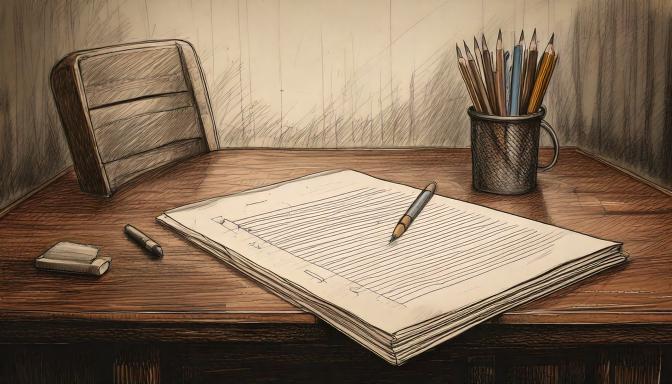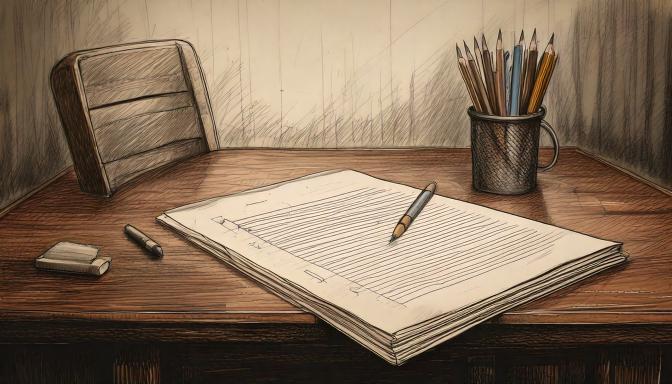Scriptwriting for Beginners:

One Sunday afternoon. Sunlight filters through the curtains. Shweta and I are sitting on a video call, notebooks out, snacks on hand.
shweta: So... I watched this short film yesterday, and now I really want to try writing my own script. But I have no idea where to start.
Me: Oooh, welcome to the writer’s club. Don’t worry—I’ve got your back. Let’s walk through it step by step. Writing your first script can feel big, but it’s totally doable. You ready?
shweta: Teach me everything.
Me: Buckle up, future screenwriter. Let’s dive in.
Step 1: Everything Starts With an Idea
Me: First things first, every script begins with a simple idea. Think of it like a tiny seed.
shweta: Like... what kind of seed?
Me: A story seed. A question, a thought, a “what if.” For example, “What if a girl found a pen that could write the future?”
shweta: Ooh! That’s cool.
Me: Right? It doesn’t have to be fancy. Just something that makes you excited. Then, we build around it.
shweta: So… I just need a fun idea to start?
Me: Exactly. No need to be perfect or completely original. Your unique twist is what makes it special. Got something in mind?
shweta: Maybe... a boy who wakes up in someone else’s dream?
Me: See?! That’s perfect. Write it down. That’s your spark.
Step 2: Know Your Characters and What They Want
Me: Now that you have a spark, let’s talk characters. Every good story follows a character who wants something—and faces challenges getting it.
shweta: Okay. So I need a main character and a goal?
Me: Yep! Let’s say your dream-traveling boy—what does he want?
shweta: Hmm… maybe to get back to his real body?
Me: Great. That’s his goal. Now what’s in his way?
shweta: Maybe the dream changes every night and he loses parts of his memory each time.
Me: YES! That’s your conflict. Every story needs tension—problems, roadblocks, choices. It’s what keeps us watching.
Step 3: Outline the Big Picture
shweta: So… I have my idea and a character. Can I start writing?
Me: Almost. But trust me—it helps to make a rough outline first. Nothing complicated. Just:
- Beginning
- Middle
- End
shweta: Like a roadmap?
Me: Exactly! Let’s try it with your idea.
Beginning: Your character wakes up in a strange dream.
Middle: Each night, the dream gets more dangerous. He meets people who may help or trick him.
End: He finds a way to take control and return home—only to realize he’s still dreaming.
shweta: Whoa. That’s cool.
Me: Right? And now writing will be way easier because you know where you’re going.
Step 4: Learn Script Format (Don’t Worry, It’s Easy!)
shweta: But I’ve never even seen a real script before. Is the format hard?
Me: Not at all. It’s different from a novel, but it’s super logical. Let me break it down.
1. Scene Headings
Tell us where and when the scene happens.
Example:
INT. DREAM FOREST – NIGHT
(That means “Interior, Dream Forest, Nighttime”)
2. Action Lines
Describe what we see happening.
Example:
He walks through trees that whisper secrets. A glowing path appears.
3. Character Name + Dialogue
Put the name in all caps above the line they speak.
Example:
BOY
Where am I? Who’s there?
shweta: Ohhh! That’s actually simple.
Me: Yep. And don’t forget—scripts are all about what we see and hear. No thoughts, no long descriptions.
shweta: So I shouldn’t write, “He feels scared.”
Me: Right. Instead, show it:
He trembles. His hands clench into fists.
Step 5: Think Like a Movie—Show, Don’t Tell
shweta: I get it now. But how do I make it feel exciting without writing a novel?
Me: Think visually. Imagine the movie in your head. What do we see? Hear? Feel?
Examples:
- Instead of saying “It’s a stormy night,” write: Lightning cracks. Rain slaps the windows.
- Instead of “She’s nervous,” show: She bites her lip and glances around.
shweta: So it’s like directing with words?
Me: Exactly! You’re writing the blueprint for a film.
Step 6: Structure Your Story in Three Acts
shweta: Okay, I’m ready to write. But how do I know if the story flows well?
Me: Great question. Let’s use the three-act structure. It’s like the secret sauce behind most great movies.
Act 1 – The Setup
- Introduce characters and their world.
- Show what they want.
- Add a twist or problem that changes everything.
Act 2 – The Struggle
- They face bigger problems.
- They learn and grow.
- Maybe they fail and feel like giving up.
Act 3 – The Solution
- Big finale.
- They take action.
- Things resolve (happy or not).
shweta: So my boy realizes the dream world is controlled by emotions, and he has to face his fear?
Me: YES. That’s your climax. Every act pushes the story forward.
Step 7: Make Dialogue Sound Real
shweta: Dialogue always sounds cheesy when I write it.
Me: That’s normal. The trick? Make it sound like real speech, but cleaner.
Tips for Dialogue:
- Use contractions (say “I’m” not “I am”)
- Let people interrupt or trail off
- No long speeches (unless it fits the character)
Example – Too Formal:
I am very upset that you lied to me.
Better:
You lied. I trusted you.
shweta: That does feel more real.
Me: Want to make it stronger? Read your dialogue out loud. If it sounds weird, rewrite it.
Step 8: Write That First Draft—Don’t Stress
Me: Now it’s time for the first draft. Just write it. Don’t stop to fix every word.
shweta: But what if it’s bad?
Me: It will be. That’s the point. First drafts are messy. You’re just getting the clay on the table.
shweta: Okay… so I should just keep going?
Me: Yes! Keep momentum. Even if a scene feels awkward. You’ll fix it later.
Step 9: Revision = Magic
shweta: I finished my draft! Now what?
Me: Amazing! Now… put it away for a day. Then read it with fresh eyes.
During Revision:
- Cut scenes that don’t matter.
- Check if every line of dialogue has a purpose.
- Fix anything confusing.
- Read it aloud or ask someone to read it.
shweta: That sounds hard.
Me: It’s like polishing a gem. It takes time, but the result shines.
Step 10: Keep Practicing and Have Fun
shweta: What if no one likes it?
Me: Doesn’t matter. Writing isn’t about getting it “right.” It’s about expressing you. Every script you write makes you better.
shweta: What if I mess it up and people don’t get what I’m trying to say?
Me: That fear? Totally normal. Every writer feels that. But here’s something I’ve learned—writing a script isn’t about being perfect, it’s about being brave. You’re putting your thoughts into scenes, your heart into characters, your voice into every line of dialogue. That’s powerful. And even if the first version doesn’t turn out exactly like you imagined, it’s still yours. You created something from nothing. You gave life to a story that didn’t exist before you sat down and wrote it. Think about that for a second—it’s kind of magic, right? You’re a storyteller now. The more you write, the better you’ll get. You’ll learn what works, what feels right, and how to trust your instincts. And trust me, your instincts are strong. So don’t focus on whether people “get it” yet—focus on saying what you need to say. The rest will come.
shweta: I guess it’s like leveling up in a game.
Me: Exactly. One script becomes three. Then you write one that blows you away.
Bonus: Helpful Tools
Me: Want some cool tools to help?
- WriterDuet or Celtx – Free scriptwriting apps
- Read scripts online – Try reading real ones from movies you love
- Watch short films – See how story and dialogue work on screen
shweta: I’m feeling so inspired right now.
Me: You should be! Your idea is awesome. Your voice matters. Now go write that story, one scene at a time.
shweta: I’m starting tonight.
Me: I’ll check in tomorrow. I want to read the first page!
Final Words: Your Story Deserves to Be Told
Telling stories isn’t just about writing—it’s about sharing something from your heart. If you’ve ever dreamed of seeing your words on screen, now’s your chance to try. Start simple. Write what you care about. Let your imagination guide you.
Just like I told shweta—you can do this.










